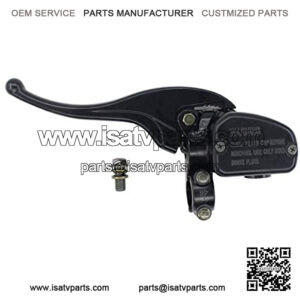If you’re not having any success bleeding the master cylinder just by pumping, you can try using a hand pump brake bleeding tool.
Depending on what model you get, these can be used for both pressing brake fluid through the master cylinder or sucking brake fluid down by utilizing vacuum.
The tool comes with a rubber adapter that can be inserted into the outlet hole on the reservoir. Follow the tool directions and press brake fluid back into the master cylinder assembly until no more bubbles appear in the reservoir.
Alternatively, you can switch the tool over to vacuum and suck brake fluid down from the reservoir and into the too through the same outlet port. If this does not help, you likely have a bad master cylinder and need to rebuild it to get it to start pumping again.
How to bleed the rear brake master cylinder
The rear brakes on many ATVs will have their own master cylinder. To bleed it properly, it is best to remove it and properly bench bleed it.
- Remove the master cylinder assembly, including the hose that goes to the rear brake caliper. Use a rag so that you don’t spill brake fluid on paint or plastic.
- Move the whole assembly over to your workbench. Find a way to keep it stable, but be careful if you put it in a vise. The aluminum or plastic materials will break if you apply too much pressure.
- Open the lid of the reservoir and top it off with brake fluid.
- Put the free end of the brake line back into the reservoir and start pumping slowly. Only pump about 80% of the overall travel before you start over, or you may damage the piston seals inside the cylinder.
- Continue pumping until no more air bubbles are coming out of the brake line, just a steady stream of brake fluid.
- Alternatively, you can direct the free end of the brake line into a separate container. Please make sure you add more brake fluid into the reservoir when it is running low. As an upside, this way of doing the job will completely flush the system, replacing the old brake fluid with new.
- Keep the rubber hose submerged in brake fluid when you are done pumping. Clampdown the rubber hose near the caliper fitting to not let any air back into the system. Now you can safely take the hose out of the reservoir and reinstall the cover.
- Reinstall the assembly onto the ATV.
- Remove the clamp from the rubber hose and bleed the brakes normally.
Why can’t you bleed the brakes the standard way to bleed the master cylinder?
After getting such a large amount of air into the master cylinder, you will likely have difficulty getting it all out with just the manual ways of pump-bleeding. That is if you can get it to start pumping fluid at all.
Inside the master cylinder, there are a lot of pockets and passages where air can get trapped. The flow of brake fluid alone will not be able to reach it all and get it out.
Also, you are fighting gravity. All of the air inside the system wants to go up and into the master cylinder.
Vacuum bleeding may work, but not always. Air may still be trapped within these passages, even after performing a proper vacuum bleed. But it is worth trying if you already own a vacuum bleeder or can borrow one.
You may be lucky and achieve a decent result by just adding fluid and bleeding as normal. But you will likely spend less time and get a better overall result if you bleed the master cylinder properly right away.
About ATV Master Cylinder
“atv master cylinder rebuild”
“atv master cylinder bleeding”
“atv master cylinder rebuild kit”
“atv master cylinder problems”
“how to bleed atv master cylinder”
“how to tell if atv master cylinder is bad”

